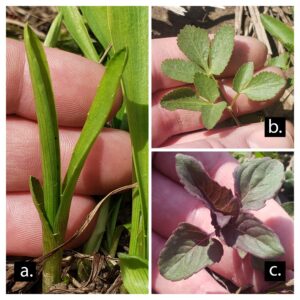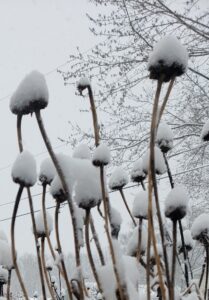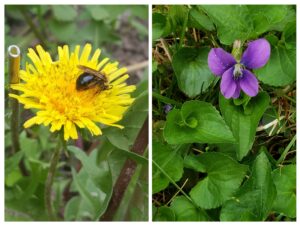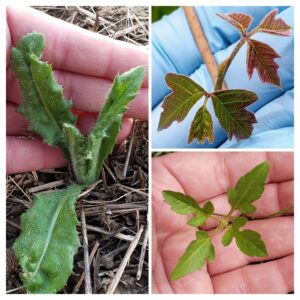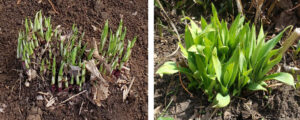
Fig. 1 – Left: Hosta emerging with tightly rolled leaves. Right: Rattlesnake master has long, fibrous leaves that begin to open upon emergence.
It’s time for spring cleaning the herbaceous perennial garden, but be careful not to pluck out any of your favorite flowers. With all the green quickly sprouting up, it may be difficult to tell friend from foe. Established herbaceous perennials will emerge from the ground in the same location as the previous year and are usually quite obvious. With temperatures rising, Hosta and Rattlesnake Master are making a fast appearance (Fig. 1). However, many of our native perennials will readily propagate from seed, providing the opportunity to expand or fill in the garden, as long as they aren’t thrown out with the weeds. A few prolific perennials to look for include Rattlesnake Master (Eryngium yuccifolium), Golden Alexanders (Zizia aurea), and Bee Balm (Monarda didyma) (Fig. 2). These will spread quickly, especially if you are in the mind set of “leaving the leaves and saving the stems” for our wildlife. The leaves, stems, and seedpods provide habitat and food for birds and insects over the winter, as well as creating garden interest for you during the cold, dark days (Fig. 3).
- Fig. 2a – In its early stages, Rattlesnake Master may be confused for a typical grass, possibly even corn, but is distinguished by the small spines forming on the leaf margins. Fig. 2b – With its hairless, compound leaves, our native Golden Alexanders at this stage can easily be confused with the invasive and noxious wild parsnip. Fig. 2c – Bee Balm has simple, opposite, and fuzzy leaves with a square stem. The purplish hue of the leaves may be confused with purple dead nettle at a distance, but the similarities stop there.
- Fig. 3 – Snow piled on the seed heads of Purple Coneflower (Echinacea purpurea).
Since a weed is simply an unwanted plant, everyone has an opinion on many of the plants that are popping up. Dandelion (Taraxacum officinale) and Wild Violet (Viola sororia) are often fiercely debated on whether they are weeds (Fig. 4). Both plants provide food early in the season for wildlife and pollinators, but they will also invade a lawn. So, whether or not dandelions and violets are considered weeds may be a personal question. However, there are some plants that are undoubtedly a weed, especially when found in the garden. There are native species, like Giant Ragweed (Ambrosia trifida) and Poison Ivy (Toxicodendron radicans), that are always unwelcome, but birds will unknowingly bring the seeds in from surrounding areas (Fig. 5). Then there are plants that the government may designate as a noxious weed if it is found to cause significant harm to people. For example, Canada Thistle (Cirsium arvense) is a herbaceous perennial that will quickly colonize an area by root propagation and seed dispersal (Fig. 5). Canada Thistle is classified as a noxious weed in Indiana, along with many other states, and it is illegal to let flower or go to seed.
- Fig. 4 – Left: Dandelion. Right: Wild Violet
- Fig. 5 – Left: Canada Thistle. Top-right: Poison Ivy. Bottom-right: Giant Ragweed
To weed or not to weed? If the government hasn’t declared it noxious, then only you can answer this personal question.
